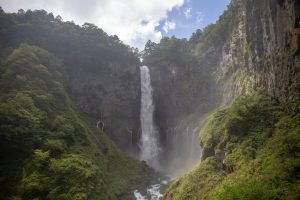 Nikko is a town at the entrance to Nikko National Park, most famous for Toshogu, Japan’s most lavishly decorated shrine and the mausoleum of Tokugawa Ieyasu, the founder of the Tokugawa shogunate. Nikko is a peaceful respite, and as such, it is one of most iconic places to visit in the North Kanto region. Nikko is well-known for its natural beauty, from verdant forests, rolling hills and breathtaking waterfalls to raging rivers, streams and a beautiful lake.
Nikko is a town at the entrance to Nikko National Park, most famous for Toshogu, Japan’s most lavishly decorated shrine and the mausoleum of Tokugawa Ieyasu, the founder of the Tokugawa shogunate. Nikko is a peaceful respite, and as such, it is one of most iconic places to visit in the North Kanto region. Nikko is well-known for its natural beauty, from verdant forests, rolling hills and breathtaking waterfalls to raging rivers, streams and a beautiful lake.
Tour Itinerary
Kegon Falls Kegon Falls is located at Lake Chūzenji in Nikkō National Park near the city of Nikkō, Tochigi Prefecture, Japan. The falls were formed when the Daiya River was rerouted by lava flows. Historically known as one of Japan’s top three greatest waterfalls, Kegon Falls offers stunning views every season. Spring is lush with flora, while in summer, its waters attract flocks of migrating Asian house martins.
 Lake Chuzenji also called Sea of Happiness, is a scenic lake in Nikkō National Park in the city of Nikkō, Tochigi Prefecture, Japan. It was created 20,000 years ago when Mount Nantai erupted and blocked the river. The lake has a surface area of 11.62 km² and a circumference of 25 km.
Lake Chuzenji also called Sea of Happiness, is a scenic lake in Nikkō National Park in the city of Nikkō, Tochigi Prefecture, Japan. It was created 20,000 years ago when Mount Nantai erupted and blocked the river. The lake has a surface area of 11.62 km² and a circumference of 25 km.
Nikko Tosho-gu Shrine is the most famous sightseeing attraction in Nikko and is popular for its many colorful buildings which are richly decorated with gorgeous carvings. The shrine is dedicated to the spirit of the shogun Tokugawa Ieyasu (1543 – 1616), and it is also the location of his grave.
Shinkyo Bridge Nikko’s Shinkyo Bridge is a sacred river crossing which officially belongs to nearby Futarasan Jinja Shrine. One of Nikko’s best-known sightseeing spots, the elegant arc of this bridge crosses the Daiya-gawa River and its vermilion and black lacquer contrasts beautifully with the natural scenery about it.
Irohazaka Route is a pair of spectacular sightseeing roads connecting the World Heritage-listed town of Nikkō, around 150km north of Tokyo, with serene Lake Chuzenji in the mountainous Oku-Nikkō region. Centuries ago, mountain ascetics would walk this winding route to reach sacred Mt. Nantai or Chuzenji temple from Nikkō.
 Nikko National Park is a complete package, providing spiritual experiences, adrenaline-pumping adventure, serene trail walks and cultural pursuits.
Nikko National Park is a complete package, providing spiritual experiences, adrenaline-pumping adventure, serene trail walks and cultural pursuits.
Akechidaira Observation Area Best to explore the spectacular view of Kegon Falls, Lake Chuzenji, and the scenery of Mt. Nantai from this deck. The Akechidaira Observation Deck is famous as a spot for viewing Nikko’s splendid autumn leaves.
Edo Wonderland Nikko Edomura Edo Wonderland Nikko Edomura is a theme park dedicated to bringing visitors the culture and atmosphere of the Edo period (1603-1867). The park recreates a small Edo town with actors and actresses playing roles for attractions, restaurants, and services.
Nikko Futarasan Shrine Established in the 8th century in dedication to one of Nikko’s mountain gods Mt. Nantai, Futarasan-jinja Shrine represents the spiritual heart of the area. Although not as grand and ornate as its neighbors, Toshogu Shrine and Rinnoji Temple , Futarasan-jinja Shrine boasts the mountain behind it as the main place of worship.
 Senjogahara Field “Senjogahara” means “field of battle”. According to a legend, the god of Mt. Nantai and the god of Mt. Akagi (Gunma Prefecture) had fought for the ownership of Lake Chuzenji. The god of Mt. Nantai changed himself into a lot of snakes, and Mt. Akagi changed himself into many centipedes, and they had a battle at this area. Therefore, “Senjogahara” was given to this field. Of course, Mt. Nantai won the battle. It is also a popular spot in this area, and we can see many native wildflowers in summer.
Senjogahara Field “Senjogahara” means “field of battle”. According to a legend, the god of Mt. Nantai and the god of Mt. Akagi (Gunma Prefecture) had fought for the ownership of Lake Chuzenji. The god of Mt. Nantai changed himself into a lot of snakes, and Mt. Akagi changed himself into many centipedes, and they had a battle at this area. Therefore, “Senjogahara” was given to this field. Of course, Mt. Nantai won the battle. It is also a popular spot in this area, and we can see many native wildflowers in summer.